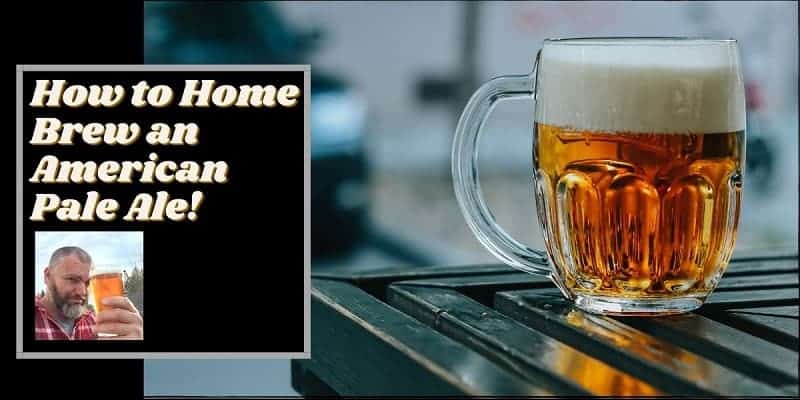The American Pale Ale is one of the most versatile and forgiving beers you could ever brew. When learning how to home brew an American Pale Ale you will discover that you can literally mix and match hops, yeast, and even grains to an extent to create your ideal beer tailored just the way you like it.
In this post I am going to show you how to not only brew this delicious style of beer, but I am also going to provide you with an American pale ale recipe, show you the ingredients and equipment required as well as walk you through step by step how to brew one. 
What is An American Pale Ale
To brew this popular beer you could literally take an English pale ale recipe, replace the English grains and hops with American versions, use an American yeast instead of an English yeast and voila you have an APA.
The reason for this is that the English Pale Ale is actually the grandfather to the American Pale Ale.
Prior to the 18th century most beers were dark in color, but as technology improved to be able to control the malting process; lighter colored beers were able to be brewed and they were called “Pale Ales”.
In England of course they were using English grains and hops that gave the English pale ale its color, taste and aroma.
In North America craft beer started to become popular in the late 1970’s and one of the first beers to gain traction was a pale ale.
The American version mimicked the English version to an extent, however they increased the alcohol content, they used American grains which gave it a lighter color, and they used American hops which give it a very distinctly different taste and aroma than its English predecessor. The APA also had a much higher level of carbonation.
Sierra Nevada is the prime example of this style of beer and is actually the first ever created.
Brew Video
What it Should Look Like (Appearance)
An American Pale Ale is traditionally a very clear beer. However in recent years with the popularity of the NEIPA many breweries are making APA’s that are much closer in appearance to an NEIPA and as a result of the dry hopping techniques they are using the beer can be quite cloudy.
The color of this beer is typically a golden color. It usually has medium to medium high carbonation with nice head retention. The color of the head is off-white – white.
What the Mouthfeel Should Be Like
It should have a smooth mouthfeel and finish.
The body is light to medium and the carbonation is typically high.
How it Should Smell (Aroma)
In most cases with modern American Pale Ales you are going to get a moderate to high aroma due to the use of the American hops. Usually it will have a citrus smell to it but not always.
You usually will not get much of a maltiness aroma but it can be there in certain beers, and if it is it is usually a bready or biscuity type of aroma.
What Does it Taste Like (Flavor)
It actually tastes somewhere in the middle, kinda just right. Not as hoppy as say an IPA, but not as tasteless as a lager, and not as malt forward tasting as an English Pale Ale.
Most people consider it to have a citrus taste and in some cases there will be a slight malt taste of biscuit or bread.
The Ingredients in an American Pale Ale
Next let’s take a look at the basic ingredients you would use to brew your own APA.
Grains to Use
The grain bill with this beer is very simple. Most recipes you will find will use American 2 row. You can substitute for British pale malt if you like. The pale malt will on average typically make up 85- 95% of your grain bill.
The remainder of the grains will be Crystal malt (typically 40 Lovibond) and some home brewers will include about 3% Carapils and/or wheat to help with head retention and body.
Some brewers will include Vienna or Munich if they are looking to make their beer have a little more maltiness to it. If you want to try this, do not exceed 10% of the grain bill with these grains or you will end up making a beer that is closer to an English Ale.
The key when thinking about what grains to use is to keep it simple. The hops are really what makes this beer unique, you do not want to overpower them with maltiness.
Hops to Use
Here is where you can really allow your creative flair to go wild. Hops are what makes this ale what it is. Being an American style beer most people will of course use American hops, but the choice is yours.
Most of the time you are going to see brewers using at least one if not more of the classic C hops, such as Cascade, Centennial, Columbus and Chinook. More and more you are seeing lots of these beers brewed using the newer hops like Citra and Mosaic as well.
Experiment and have fun with trying different hops. Do some research and see which hops work well with each other.
The main things to keep in mind when deciding on hops are that your bittering hops that you add at the 60-min mark should be the higher alpha acid hops.
The flavoring hops you are going to add to the boil around the 15-min mark and the aroma hops that you are going to add around the last minute of the boil would be lower alpha acid hops.
Most brewers will also dry hop their ales. Just make sure you do not dry hop for any longer than 5 – 7 days or you will start to get off flavors that you will not enjoy.
Yeast to Use
When it comes to yeast the choices are endless and it is simply a matter of finding one that you like. You will be surprised how just by changing the yeast how different your beer will taste from one batch to the next. Yeast plays a much bigger role in the taste of a beer than most novice homebrewers realize.
I prefer dry yeasts myself just because they are so simple to use. This is an American beer so I use an American yeast and my go to is Safale US-05 by Fermentis.
American Pale Ale Recipe
The following is a simple to brew but delicious recipe.
SRM: 7
Target OG: 1.050
Target FG: 1.012
IBU: 44
Pre Boil Volume: 6.25 gallons
Post Boil Volume: 5.25 gallons
Brewhouse efficiency of 75%.
Grains
8 lbs 2 row
1 lb Crystal 40 L
1 lb Carafoam
Hops
1 oz Northern Brewer (60 mins)
2 oz Cascade (5 mins)
Yeast
Safale US-05 or American yeast of your choosing
Instructions
60 min mash at 153 Degrees Fahrenheit
60 min boil
NOTE: You can order your ingredients for this ale here.
(I’ve also included on that page a link to pick up a really good Sierra Nevada all grain beer kit clone)
Additional Resources
When it comes to actually brewing the beer I recommend that you either do so using a BIAB (brew in a bag) system or an all-in-one brewing system.
I use both and they are without a doubt the simplest and most cost effect methods of brewing all grain beer. Plus you can make some delicious beer with both of these systems.
You can read about these systems and how to use them here:
How to Use an All-In-One Brewing System
The first step to brewing any beer is to make sure you are cleaning and sanitizing your equipment, this is crucial. I explain how to do this correctly on the following post to make sure you never lose a batch:
Cleaning & sanitizing your equipment
If you are like me and you want to make a really clear beer there are methods you can implement to do that easily, I cover them on this post:
Cooling your wort quickly is also a crucial step, you want to get the temperature down and the yeast added as quickly as possible in order to avoid infection. I cover all the different methods you can use to do that here:
Fermenting this beer is done the same as any other ale. If you have never fermented an ale or need a refresher check out this post:
I would also recommend cold crashing after you are done fermenting as it will make for a much clearer beer. Details on cold crashing can be found here:
I will also from time to time filter my beer before adding it to the keg just to make sure I am getting as clear a beer as possible, if that interests you this post will help you with it:
And lastly it is time to bottle or keg your ale. Details for doing both can be found here:
And there you have it my friend you now know how to home brew an American Pale Ale. If you have any questions feel free to drop them in the comment section below and I will help you out.
If you brew one of these ales for yourself do me a favor and let me know how it turned out.
Now go get your brew awwnn!
Oh yeaaa…
Big Robb is out!

